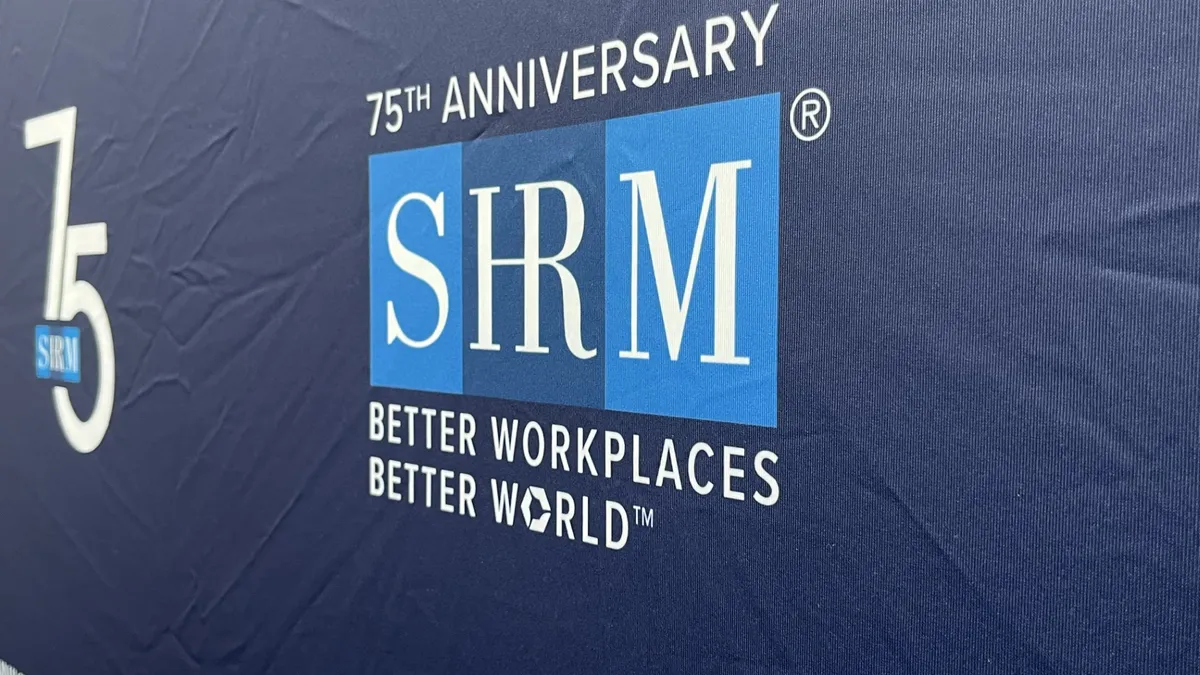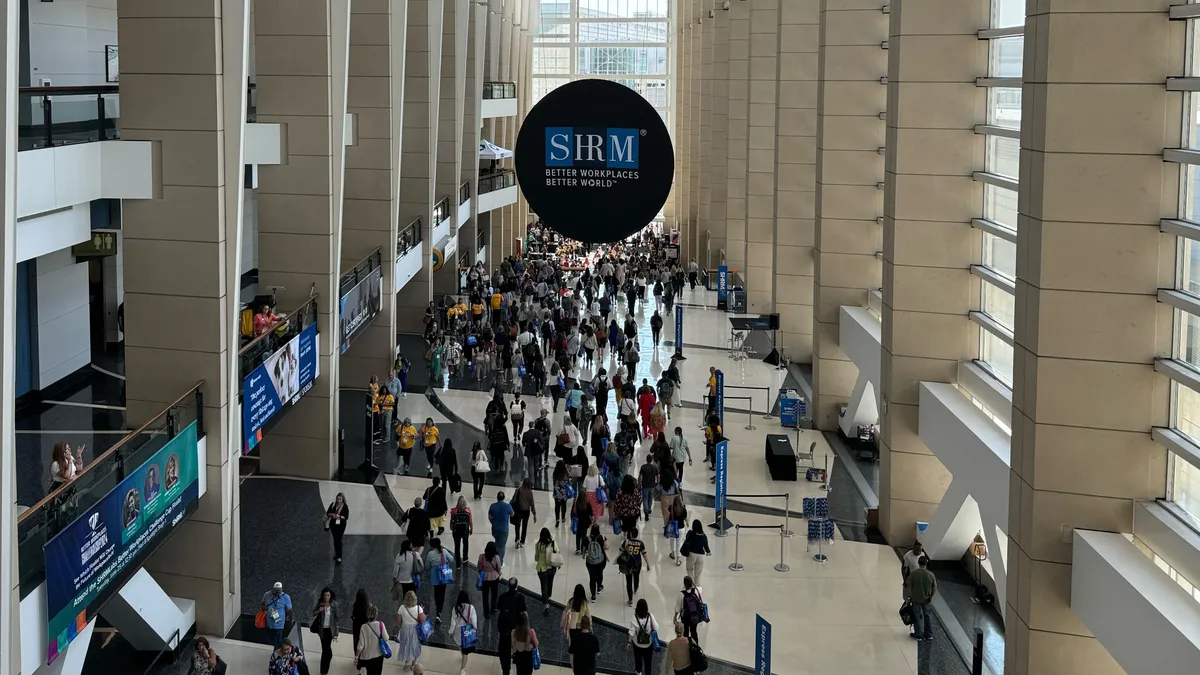CHICAGO — 2023 may be well in the rear view mirror, but the effects of that tumultuous year continue to influence what HR professionals are prioritizing in 2024 and beyond, Kerri Nelson, director of mission research for the Society of Human Resource Management, said Tuesday at the organization’s annual conference.
Inflation loomed large in 2023, Nelson said. All the while, HR was navigating the dual challenges of talent retention and acquisition amid an overarching fear of an economic slowdown that would put further pressure on department goals, she added.
At the same time, HR’s attention is being pulled multiple different directions: More than half, 57%, of HR pros said they are working beyond normal capacity right now, and 56% said they lack sufficient staff to cover the workload, according to SHRM’s 2023-2024 State of the Workplace report. One in three HR professionals in understaffed departments are looking for a new job.
“There’s a lot on HR’s plate right now,” Nelson said, outlining the topics HR professionals are focused on, and what they can do to meet these goals.
1. Maintain morale and engagement
Engagement has jumped to the top of HR’s priority list especially in the wake of the pandemic, Nelson said. More than half of workers said they are “used up” at the end of the workday, according to other SHRM research, while 45% said they feel emotionally drained from their work. On top of that, U.S. workers are collectively experiencing 171 million acts of incivility per day — a big focus for SHRM this year.
Workers who rate their workplace as “uncivil” are two times more likely than others to leave their job in the next year, the study said. And workers who are burned out are three times more likely to be actively searching for another job.
But when employers establish a sense of belonging, feelings of burnout drop dramatically. Building a community is very important for workers, Nelson said. And when workers feel fulfilled, they are more likely to go above and beyond — “critical” in a time of labor shortages, she said.
However, while 3 in 4 workers said their organizations say they care about employee mental health, 2 in 5 workers said that their organizations only “pretend to care because it’s trendy,” the study noted.
Employers need to pay attention to how these initiatives are portrayed, Nelson said, and to remember that a supportive culture is at the core of mental health support. Few workers say their leaders set good examples around mental health practices, she continued — a key way culture is communicated.
Workers are also generally unaware of the mental health benefits available to them, while 50% who are aware said they don’t feel comfortable using them, the study indicated. Workers are often told the benefits they have access to upon onboarding, but they may forget about them when they aren’t in a moment of needing them, Nelson said.
Aligning offerings with what workers actually want can go a long way; the benefits workers say they want to improve their mental health include paid time off, mental health days and flexible schedules, the study found.
2. Retain top talent
About half of organizations surveyed by SHRM on talent trends said they had difficulty retaining full-time employees in the last 12 months. Quit rates spiked in April 2022 after a serious dip around the time of the pandemic. While quit rates have since come down, they are still fairly elevated, signaling a tight labor market, Nelson said.
Employers said their top retention challenges are: noncompetitive pay; employees’ personal reasons; poor people managers or leaders; limited advancement opportunities; and an inability to offer flexible work arrangements.
To address the compensation problem, 78% of organizations said they plan to pay more for talent in 2024, according to the study. More than half said they plan to increase pay by between 3% to 4.9%. But organizations struggling to get there due to budget limitations can “build currency” in other ways, Nelson said.
A positive workplace culture also can go a long way in keeping workers on board, the survey noted. Four of the top five reasons employees seek to leave all had something to do with culture, including career growth opportunities, bad management, poor learning opportunities and unfair treatment. Similarly, “by investing in your people managers, your leaders stay with you longer but [so does] the rest of your workforce,” Nelson said.
3. Find and recruite talent with the necessary skills
The applicant skills gap issue peaked in 2022, with 91% of employers saying they had trouble recruiting for full-time positions in the last 12 months, according to SHRM data. In 2024, the crisis lessened, but some organizations reported a need for new skills that year — meaning employers were trying to cover both old and new skills gaps at the same time.
So why are employers facing these recruiting challenges? Supply and demand remains a key consideration; many organizations reported a low number of applicants, on top of competition from other employers, SHRM data shows. And the latest unemployed per job opening ratio is 0.7 — which means “even if we filled all the open jobs with people who were open and ready to work, that means 30% of jobs would go unfilled,” Nelson said.
Some employers also pointed to a lack of experience among applicants as well as difficulty keeping up with market pay. The most effective recruiting strategies, according to HR professionals surveyed, include — of course — increasing pay, but also offering more flexible work arrangements and training employees to take on hard-to-fill positions. Employer responses show these strategies are “underutilized,” Nelson said.
A cross-training strategy may be especially effective. “There’s definitely room to try this out and do something different,” Nelson said. “This is something that can be a win-win,” she continued, especially as employers persistently struggle to find the right skills to fill open jobs.
Additionally, recruiters can seek untapped talent pools, such as workers without degrees. Hiring managers may “really want that degree, but don’t know why,” Nelson said. Often those jobs can be opened to talent that gains skills in different ways.
4. Reduce costs and increase efficiencies
When SHRM asked HR executives about their greatest barriers to success, most pointed to a lack of time and dedicated personnel — and only 19% said they expect to be able to increase their department headcount in the coming year.
Cue the rise of artificial intelligence, Nelson said. Nearly half of HR professionals surveyed said using AI to augment or support HR-related activities has become a priority for their organizations, but only 12% believe their organization is effectively integrating AI into the workplace, often lacking a “clear playbook,” Nelson said.
The top three ways HR is using AI, according to SHRM data, include:
- Recruiting, interviewing and hiring, such as to generate job descriptions and customizing job postings, which professionals surveyed say has saved time and reduced recruiting costs.
- Learning and development, through recommending or creating personalized learning opportunities and tracking employees’ L&D progress, which has helped employee engagement in those programs, the survey said.
- Performance management, to assist managers with feedback and employees with goal setting.
While some HR pros are still concerned that AI will displace jobs at their organizations, the survey also showed that those using it are very likely to say AI has “transformed existing jobs rather than displacing jobs.”
Planning ahead can also go a long way, Nelson said. More than half of workers say they have used AI for work-related tasks, even if only 3 in 10 organizations say they have been proactive in training employees to use AI — meaning workers are using it even if an organization doesn’t have a policy on it. Only a quarter of organizations have an AI policy at all, according to SHRM data.
“AI is not a standalone solution. It has to be paired with human intelligence,” Nelson said, “and HR professionals are in agreement with this in our survey.”
HR professionals can use what they have and combine it with these peer insights to address this year’s strategic priorities. “Make sure to lean into your current strengths,” Nelson said, “but also be curious and open to building new capabilities to attract and retain your current workforce.”





















